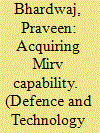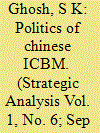| Srl | Item |
| 1 |
ID:
130001


|
|
|
| 2 |
ID:
110605


|
|
|
|
|
| Publication |
2012.
|
| Summary/Abstract |
In the latest sign of political problems for the planned replacement of the United States' nuclear-armed submarines, Congress has required the Navy and U.S. Strategic Command (STRATCOM) to prepare a report on options for replacing the fleet.
|
|
|
|
|
|
|
|
|
|
|
|
|
|
|
|
| 3 |
ID:
115786


|
|
|
| 4 |
ID:
062695


|
|
|
| 5 |
ID:
156597


|
|
|
|
|
| Summary/Abstract |
The author describes the history of creating nuclear weapons in the PRC and discloses the essence of its present nuclear doctrine. He also characterizes in detail the Missile Forces of the People's Liberation Army of China and makes certain conclusions concerning the development prospects of the PRC armed forces.
|
|
|
|
|
|
|
|
|
|
|
|
|
|
|
|
| 6 |
ID:
119886


|
|
|
|
|
| Publication |
2011.
|
| Summary/Abstract |
Fifty years ago, the Space Age was not yet five years old but the broad outlines of US space interests were visible. The year 1962 saw the first US human orbital flight by John Glenn on a converted Atlas Intercontinental Ballistic Missile (ICBM). Telstar 1 demonstrated the first transatlantic television, telephone, and fax transmissions by an active satellite. The United Kingdom became the third country to operate a satellite with the US launch of Ariel 1. Later that year, both Telstar 1 and Ariel 1 were seriously damaged when the United States detonated a 1.4-megaton nuclear device 250 miles over the Pacific Ocean in what was titled the Starfish Prime test. The Glenn flight and the Starfish Prime test respectively represented the civil and military bookends of US space interests that were to shape international, commercial, and scientific space activities.
|
|
|
|
|
|
|
|
|
|
|
|
|
|
|
|
| 7 |
ID:
146294


|
|
|
|
|
| Summary/Abstract |
WHILE CLAMORING to rid the world of all its nukes, pursuing a propaganda ballyhoo that it has orchestrated with support from a large group of allies and numerous deceived champions of immediate nuclear disarmament, the United States is aiming nuclear weapons and cutting-edge conventional arms at practically all countries. This is essentially what the Pentagon's strategic "triad" program is all about - it is a plan to build an armed forces group consisting of nuclear weapons, a missile defense system and precision conventional offensive arms that would be able to carry out an unexpected destructive strike against a target in any spot on the globe. "No target on the planet or in space would be immune to American attack," said U.S. military analyst William Arkin. "The U.S. could strike without warning whenever and wherever a threat was perceived, and it would be protected by missile defenses."
|
|
|
|
|
|
|
|
|
|
|
|
|
|
|
|